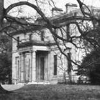Heritage in West Lothian
West Lothian's past is still very much present all around us. Important historic sites like Cairnpapple and Linlithgow Palace, stately homes like Hopetoun and the Binns, and the many museums and heritage attractions all help to bring the past alive.

Prehistoric
West Lothian sits astride the main routes between Edinburgh and the west, and also between Edinburgh and Stirling, making it a significant place in the past. Its most important prehistoric site is Cairnpapple in the Bathgate Hills - a site of national significance. From here - one of the highest points in the county - you get great views up to the Highlands, south towards the Pentlands, and from the Forth to the Clyde. It's easy to see why our prehistoric ancestors chose it as a place of ceremonial and burial.
Medieval Period
In the medieval period the king built a defensive fort on the edge of Linlithgow Loch, from where he could control and administer the surrounding lands. In the 15th century this was rebuilt as the magnificent royal Linlithgow Palace. Though damaged by fire in 1746, the ruins still reveal its past glories.
Early Industries

Heavy Industries
The heavy industries brought prosperity for the few, employment for the many. The population of the industrial areas grew rapidly, and new villages sprang into being to house the mining workforce. Because of the speed of growth, miners' rows were thrown up as quickly and cheaply as possible, leaving a legacy of poor housing.
James Young and Robert Bell and others pioneered the world's commercial oil industry right here in West Lothian. Workers came from far and near to the new jobs in the mines and the oil works. Though American petroleum was discovered some ten years after the start of West Lothian's shale industry (opens new window), the local engineers continually refined their processes to keep Scottish shale oil competitive.
First World War
By the outbreak of the First World War, West Lothian was in its heyday: strategically located in the Central Belt between Edinburgh and Glasgow; with many thousands employed in shale, coal, and the other heavy industries; supplying the oil which powered the mighty Royal Navy; but one of the worst housed counties in the whole of Scotland. Over the next fifty years the building of thousands of council houses gradually provided a decent house for every local family.
Since the war, heavy industry has gone, and been replaced by electronics and service industries. Today West Lothian is once more a desirable place to live and work, but the past is all around us...
Experience West Lothian's rich heritage by visiting some of its historic sites.
As well as our own museums, there are many other sites you can visit in West Lothian to explore our local history:

- Hopetoun House (opens new window)
- House of the Binns (opens new window)
- Linlithgow Palace
- Torphichen Preceptory
- Peaceful churchyards and cemeteries
- Ancient churches
- Cairnpapple (opens new window)
For information about these and many more historic buildings and sites, visit the Local History Library and Family History in the Dalyell Suite at the new Linlithgow Partnership Centre. There you will find thousands of books, photos and maps about sites of interest, their archaeology, architecture, history and associations.
Archaeology
The archaeology of West Lothian is rich and varied. It ranges from prehistoric sites to 20th century industrial sites.
For information on archaeological sites, contact the West of Scotland Archaeology Service (opens new window):
Tel. 0141 287 8330
Email: enquiries@wosas.glasgow.gov.uk
For information on all historic buildings and sites in West Lothian, search the Canmore (opens new window) website, part of the Royal Commission on the Ancient and Historic Monuments of Scotland (RCAHMS).
Cemeteries and churchyards
If you have an enquiry relating to burials after 1855, you should contact the Council's Cemeteries Service.
The West Lothian Family History Society (opens new window) have a researched index of burials through the council and may be able to help you. Their volunteers are usually available 11am-3pm Wednesdays and Thursdays in The Lanthorn Library, Livingston and 11am-3pm Tuesdays and Fridays in the Local History Library in Linlithgow.



